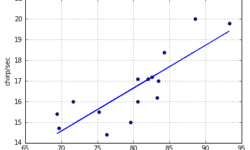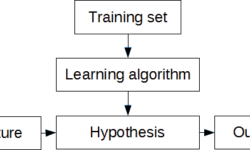Linear regression – learning algorithm with Python

In this post, we will demystify the learning algorithm of linear regression. We will analyze the simplest univariate case with single feature X wherein the previous example was temperature and output was cricket chirps/sec. Let’s use the same data with crickets to build learning algorithm and see if it produces a similar hypothesis as in excel. As you may already know from this example, we need to find linear equation parameters θ0 and θ1, to fit line most optimally on the given data set: y = θ0 + θ1 x x here is a feature (temperature), and y – output value (chirps/sec). So how are we going to find parameters θ0 and θ1? The whole point of the learning algorithm is doing this iteratively. We need to find optimal θ0, and θ1 parameter values, so that approximation line error from the plotted training set is minimal. By doing successive corrections to randomly selected parameters we can find an optimal solution. From statistics, you probably know the Least Mean Square (LMS) algorithm. It uses gradient-based method of steepest descent.






